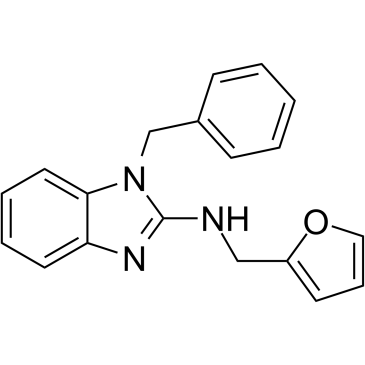| DC70937 |
ZINC17988990
|
ZINC 17988990 is a potent, selective inhibitor of TRPV5 mediated currents, inhibits rbTRPV5/hTRPV5 with IC50 of 106/177 nM, showing marked selectivity for TRPV5 over TRPV6.ZINC 17988990 shows no activity on other TRP channels (TRPV1, TRPV3, TRPV4 and TRPM8) at 1-3 uM, and moderate inhibition on TRPV3 and TRPM8 at >10 uM.ZINC17988990 (10 uM) fully inhibited Ca2+ signals elicited by application of external Ca2+ in HEK293 cells transfected with TRPV5, but had no effect in cells expressing TRPV6. |
| DC70523 |
JNJ-28583113
|
JNJ-28583113 (JNJ28583113) a potent, selective, brain penetrant TRPM2 antagonist with IC50 of 126 nM (hTRPM2).JNJ-28583113 shows similar potency against species chimpanzee and rat TRPM2 with IC50 of 100 and 25 nM, respectively.JNJ-28583113 shows no significant (IC50>10 uM) reactivity towards PARP or PARG and a panel for multiple known kinases GPCRs and ion channels, nine other TRP channels with exception of TRPM5 (IC50<1 uM).Blocking TRPM2 via JNJ-28583113 caused phosphorylation of GSK3α and β subunits in cell assays.JNJ-28583113 also protected cells from oxidative stress induced cell death as well as morphological changes induced by non-cytotoxic concentrations of H2O2。JNJ-28583113 blunted cytokine release in response to pro-inflammatory stimuli in microglia.JNJ-28583113 was brain penetrant but not suitable for systemic dosing as it was rapidly metabolized in vivo, but the in-vitro pharmacology of JNJ-28583113 is the best in class. |
| DC47315 |
ML-SI3
|
ML-SI3 is a potent TRPML channel inhibitor with IC50s of 4.7 µM and 1.7 µM for TRPML1 and TRPML2, respectively. |
| DC46872 |
Evifacotrep
|
Evifacotrep, a short transient receptor potential channel 5 (TRPC5) antagonist (WO2020061162, compound 100), can be used for the research of neurological diseases. |
| DC46871 |
Vocacapsaicin
|
Vocacapsaicin (CA-008), a prodrug of Capsaicin, is a first-in-class non-opioid TRPV1 agonist. Vocacapsaicin can provide meaningful and long-lasting pain relief. |
| DC46377 |
ML-SA1
|
ML-SA1, as a selective TRPML agonist, inhibits Dengue virus 2 (DENV2) and Zika virus (ZIKV) by promoting lysosomal acidification and protease activity. The IC50 value of ML-SA1 against DENV2 RNA and ZIKV RNA is 8.3 μM and 52.99 μM, respectively. ML-SA1 induces autophagy. ML-SA1 can be used for the research of broad-spectrum antiviral. |
| DC45287 |
TRPC6-PAM-C20
|
TRPC6-PAM-C20 is a selective TRPC6 positive allosteric modulator. TRPC6-PAM-C20 selectively activates TRPC6 over other TRP channels and also activates TRPA1. TRPC6-PAM-C20 induces transient increase in intracellular Ca2+ in HEK cells expressing TRPC6 (EC50=2.37 μM). |
| DC28758 |
Umbellulone
|
Umbellulone is an active constituent of the leaves of Umbellularia californica. Umbellulone stimulates the TRPA1 channel in a subset of peptidergic, nociceptive neurons, activating the trigeminovascular system via this mechanism. |
| DC28702 |
GFB-8438
|
GFB-8438 is a potent and subtype selective TRPC5 inhibitor, with IC50s of 0.18 and 0.29 μM of hTRPC5 and hTRPC4, respectively. GFB-8438 shows excellent selectivity against TRPC6, other TRP family members, NaV 1.5, as well as limited activity against the hERG channel. GFB-8438 protects mouse podocytes from injury induced by protamine sulfate model. |
| DC11325 |
RN-1734
|
RN-1734 is a transient receptor potential vanilloid 4 (TRPV4) antagonist, blocking calcium influx induced by the TRPV4 agonist 4α-phorbol 12,13-didecanoate with IC50 values of 2.3, 5.9, and 3.2 µM for human, mouse, and rat TRPV4, respectively. |






















